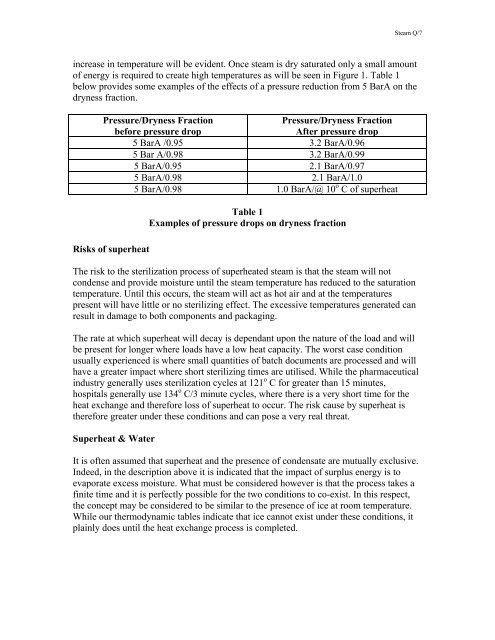THE APPLICATION OF STEAM QUALITY TEST LIMITS
THE APPLICATION OF STEAM QUALITY TEST LIMITS
THE APPLICATION OF STEAM QUALITY TEST LIMITS
You also want an ePaper? Increase the reach of your titles
YUMPU automatically turns print PDFs into web optimized ePapers that Google loves.
Steam Q/7<br />
increase in temperature will be evident. Once steam is dry saturated only a small amount<br />
of energy is required to create high temperatures as will be seen in Figure 1. Table 1<br />
below provides some examples of the effects of a pressure reduction from 5 BarA on the<br />
dryness fraction.<br />
Pressure/Dryness Fraction<br />
Pressure/Dryness Fraction<br />
before pressure drop<br />
After pressure drop<br />
5 BarA /0.95 3.2 BarA/0.96<br />
5 Bar A/0.98 3.2 BarA/0.99<br />
5 BarA/0.95 2.1 BarA/0.97<br />
5 BarA/0.98 2.1 BarA/1.0<br />
5 BarA/0.98 1.0 BarA/@ 10 o C of superheat<br />
Risks of superheat<br />
Table 1<br />
Examples of pressure drops on dryness fraction<br />
The risk to the sterilization process of superheated steam is that the steam will not<br />
condense and provide moisture until the steam temperature has reduced to the saturation<br />
temperature. Until this occurs, the steam will act as hot air and at the temperatures<br />
present will have little or no sterilizing effect. The excessive temperatures generated can<br />
result in damage to both components and packaging.<br />
The rate at which superheat will decay is dependant upon the nature of the load and will<br />
be present for longer where loads have a low heat capacity. The worst case condition<br />
usually experienced is where small quantities of batch documents are processed and will<br />
have a greater impact where short sterilizing times are utilised. While the pharmaceutical<br />
industry generally uses sterilization cycles at 121 o C for greater than 15 minutes,<br />
hospitals generally use 134 o C/3 minute cycles, where there is a very short time for the<br />
heat exchange and therefore loss of superheat to occur. The risk cause by superheat is<br />
therefore greater under these conditions and can pose a very real threat.<br />
Superheat & Water<br />
It is often assumed that superheat and the presence of condensate are mutually exclusive.<br />
Indeed, in the description above it is indicated that the impact of surplus energy is to<br />
evaporate excess moisture. What must be considered however is that the process takes a<br />
finite time and it is perfectly possible for the two conditions to co-exist. In this respect,<br />
the concept may be considered to be similar to the presence of ice at room temperature.<br />
While our thermodynamic tables indicate that ice cannot exist under these conditions, it<br />
plainly does until the heat exchange process is completed.








